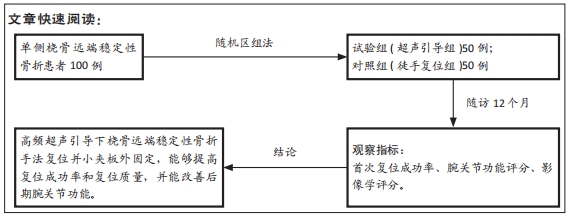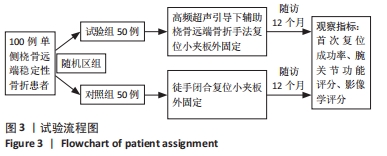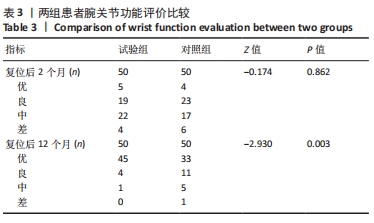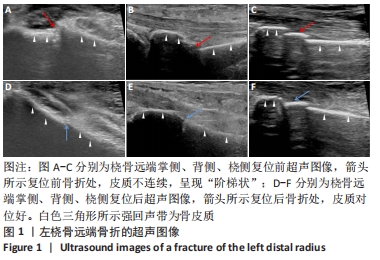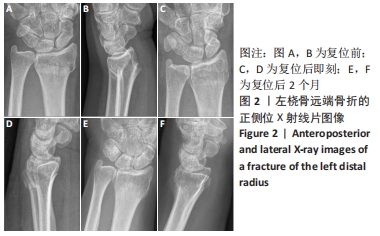[1] OCHEN Y, PEEK J, VAN DER VELDE D, et al. Operative vs Nonoperative Treatment of Distal Radius Fractures in Adults: A Systematic Review and Meta-analysis. JAMA Netw Open. 2020;3(4):e203497.
[2] FLOREK J, KOTELA I, GEORGIEW F, et al. Comparison of Radiographic Outcomes of Surgical Treatment in Patients with Distal Radial Fractures. Ortop Traumatol Rehabil. 2018;20(6):483-492.
[3] ÇALBIYIK M, IPEK D. Use of Volar Locking Plate Versus Intramedullary Nailing for Fixation of Distal Radius Fractures: A Retrospective Analysis of Clinical and Radiographic Outcomes. Med Sci Monit. 2018;24:602-613.
[4] 姜保国,张殿英,付中国,等.桡骨远端骨折的治疗建议[J].中华创伤骨科杂志,2010,12(11):1053-1056.
[5] YAZDANSHENAS H, WASHINGTON ER 3RD, MADADI F, et al. Introducing and Prospective Efficacy Comparison of an Innovative and Affordable Technique for the Treatment of Distal Radius Fractures. J Orthop. 2019;16(6):596-602.
[6] WU YS, YANG J, XIE LZ, et al. Factors associated with the decision for operative versus conservative treatment of displaced distal radius fractures in the elderly. ANZ J Surg. 2019;89(10):E428-E432.
[7] CHACHAN S, TUDU B, SAHU B. Ultrasound monitoring of fracture healing: is this the end of radiography in fracture follow-ups? J Orthop Trauma. 2015;29(3):e133-138.
[8] NERI E, BARBI E, RABACH I, et al. Diagnostic accuracy of ultrasonography for hand bony fractures in paediatric patients. Arch Dis Child. 2014;99(12):1087-1090.
[9] 向斌,朱文斌,董遵伟,等.闭合性长骨骨折及指导手法复位的超声诊断的价值[J].中国实验诊断学,2011,15(12):2145-2146.
[10] HERREN C, SOBOTTKE R, RINGE MJ, et al. Ultrasound-guided diagnosis of fractures of the distal forearm in children. Orthop Traumatol Surg Res. 2015;101(4):501-505.
[11] 陆建华,施晓健,黄莉,等.高频超声引导Colles骨折手法复位的价值[J].南通大学学报(医学版),2010,30(3):164-166.
[12] SOCRANSKY S, SKINNER A, BROMLEY M, et al. Ultrasound-Assisted Distal Radius Fracture Reduction. Cureus. 2016;8(7):e674.
[13] SABZGHABAEI A, SHOJAEE M, ARHAMI DOLATABADI A, et al. Ultrasound-Guided Reduction of Distal Radius Fractures. Emerg (Tehran). 2016;4(3):132-135.
[14] SYNN AJ, MAKHNI EC, MAKHNI MC, et al. Distal radius fractures in older patients: is anatomic reduction necessary? Clin Orthop Relat Res. 2009;467(6):1612-1620.
[15] 蒋协远,王大伟,韩士章,等.骨科临床疗效评价标准[M].北京:人民卫生出版社,2005:45-46.
[16] STEWART HD, INNES AR, BURKE FD. Functional cast-bracing for Colles’ fractures. A comparison between cast-bracing and conventional plaster casts. J Bone Joint Surg Br. 1984;66(5):749-753.
[17] FU Q, ZHU L, YANG P, et al. Volar Locking Plate versus External Fixation for Distal Radius Fractures: A Meta-analysis of Randomized Controlled Trials. Indian J Orthop. 2018;52(6):602-610.
[18] SAVING J, PONZER S, ENOCSON A, et al. Distal radius fractures-Regional variation in treatment regimens. PLoS One. 2018;13(11):e0207702.
[19] RAUDASOJA L, VASTAMÄKI H, ASPINEN S. Deterioration of initially accepted radiological alignment of conservatively treated AO type-C distal radius fractures: mid-term outcome. Eur J Orthop Surg Traumatol. 2020;30(6):1009-1015.
[20] RUNDGREN J, BOJAN A, MELLSTRAND NAVARRO C, et al. Epidemiology, classification, treatment and mortality of distal radius fractures in adults: an observational study of 23,394 fractures from the national Swedish fracture register. BMC Musculoskelet Disord. 2020;21(1):88.
[21] HJELLE AM, GJERTSEN JE, APALSET EM, et al. No association between osteoporosis and AO classification of distal radius fractures: an observational study of 289 patients. BMC Musculoskelet Disord. 2020;21(1):811.
[22] MELLSTRAND NAVARRO C, BROLUND A, EKHOLM C, et al. Treatment of radius or ulna fractures in the elderly: A systematic review covering effectiveness, safety, economic aspects and current practice. PLoS One. 2019;14(3):e0214362.
[23] 程国杰,吕发明,艾克巴尔,等.手法复位小夹板外固定治疗C型老年桡骨远端骨折的前瞻性随机对照临床试验[J].中国骨质疏松杂志,2012,17(8):636-640.
[24] BALOCH N, HASAN OH, JESSAR MM, et al. “Sports Ultrasound”, advantages, indications and limitations in upper and lower limbs musculoskeletal disorders. Review article. Int J Surg. 2018;54(Pt B):333-340.
[25] JÄSCHKE M, WEBER MA, FISCHER C. CEUS-application possibilities in the musculoskeletal system. Radiologe. 2018;58(6):579-589.
[26] WANG JC, TSAI PY, HSU PC, et al. Ultrasound-Guided Hydrodilatation With Triamcinolone Acetonide for Adhesive Capsulitis: A Randomized Controlled Trial Comparing the Posterior Glenohumeral Recess and the Rotator Cuff Interval Approaches. Front Pharmacol. 2021;12:686139.
[27] YOON JP, CHUNG SW, KIM JE, et al. Intra-articular injection, subacromial injection, and hydrodilatation for primary frozen shoulder: a randomized clinical trial. J Shoulder Elbow Surg. 2016;25(3):376-383.
[28] GALLETEBEITIA LAKA I, SAMSON F, GOROSTIZA I, et al. The utility of clinical ultrasonography in identifying distal forearm fractures in the pediatric emergency department. Eur J Emerg Med. 2019;26(2):118-122.
[29] ZHANG L, LÜ Y, LU C, et al. Treatment of the fifth metacarpal neck fracture with elastic intramedullary nail under the guidance of high frequency ultrasound. Zhongguo Xiu Fu Chong Jian Wai Ke Za Zhi. 2021;35(2):154-159.
[30] 黄克成,江红艳,朱宝林,等.超声引导下弹性髓内钉固定治疗儿童股骨骨折[J].临床骨科杂志,2019,22(5):599-600.
[31] ACKERMANN O, WOJCIECHOWSKI P, DZIERZEGA M, et al. Sokrat II - An International, Prospective, Multicenter, Phase IV Diagnostic Trial to Evaluate the Efficacy of the Wrist SAFE Algorithm in Fracture Sonography of Distal Forearm Fractures in Children. Ultraschall Med. 2019;40(3):349-358.
[32] ŞIK N, ÖZTÜRK A, KOŞAY MC, et al. Accuracy of point-of-care ultrasound for determining the adequacy of pediatric forearm fracture reductions. Am J Emerg Med. 2021;48:243-248.
[33] AUTEN JD, NAHEEDY JH, HURST ND, et al. Comparison of pediatric post-reduction fluoroscopic- and ultrasound forearm fracture images. Am J Emerg Med. 2019; 37(5):832-838.
[34] SIMARD R. Ultrasound Imaging of Orthopedic Injuries. Emerg Med Clin North Am. 2020;38(1):243-265.
[35] SHAH AB, BHATNAGAR N. Ultrasound imaging in musculoskeletal injuries-What the Orthopaedic surgeon needs to know. J Clin Orthop Trauma. 2019;10(4):659-665.
|
